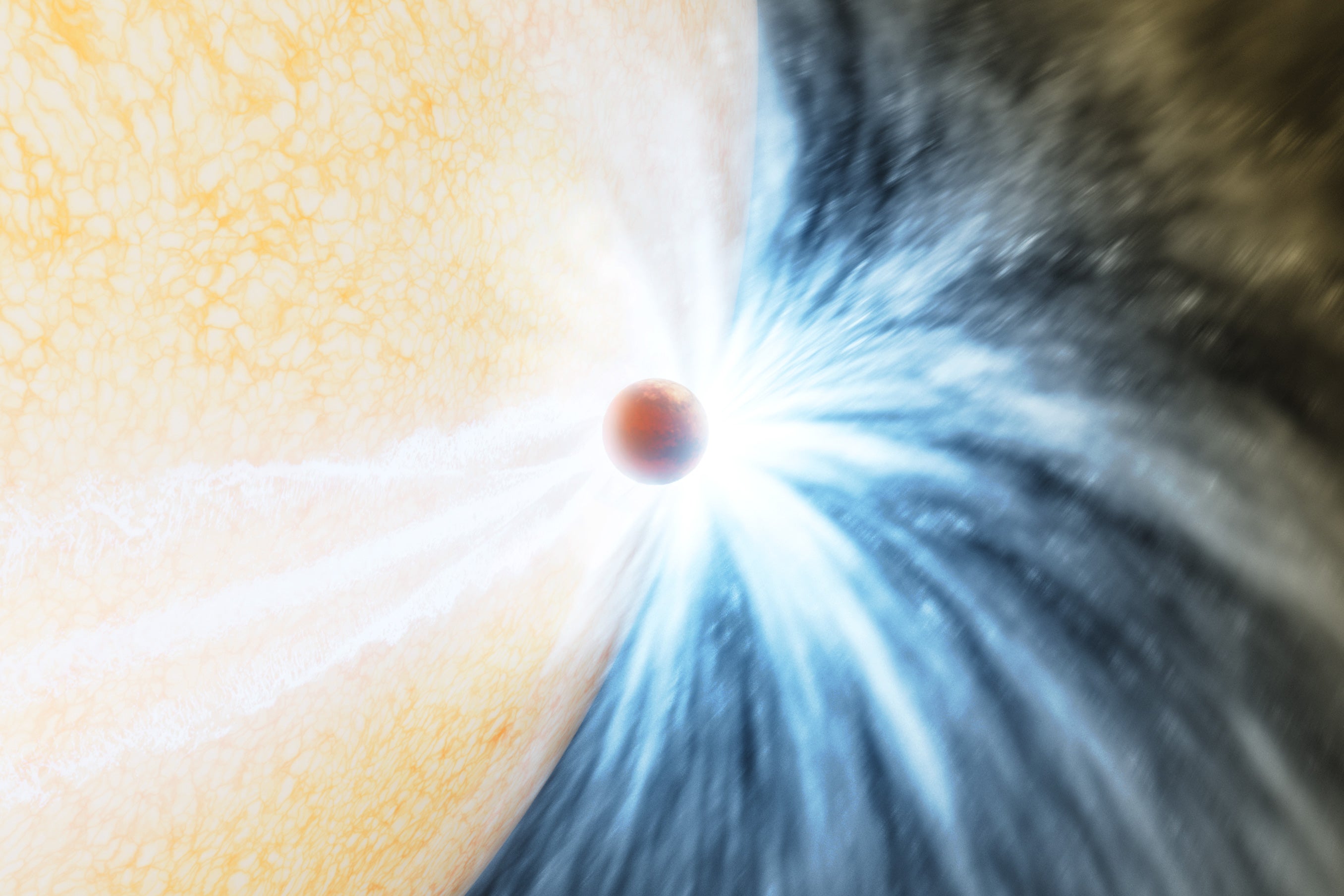
Astronomers may have for the first time witnessed a sun-like star devouring a planet, shedding light on the fate that will befall Earth in about four billion years when our dying sun swells to engulf our world, a new study finds.
By analyzing countless stars during various stages of their evolution, astronomers have discovered that as our sun and stars like it near the ends of their lives, they begin to exhaust their primary source of fuel, the hydrogen near their cores. This leads their cores to contract and their outer shells to expand and cool. During this “red giant” phase, these stars may billow out anywhere from 100 to 1,000 times their original diameter, swallowing closely orbiting planets.
“We know that this must happen to all planets that are orbiting at distances smaller than that of the Earth, but it was considered extremely challenging to provide experimental evidence for this,” study lead author Kishalay De, an astrophysicist at the Massachusetts Institute of Technology, told Space.com.
For decades, scientists have detected evidence of stars just before and shortly after the act of consuming planets. However, researchers had never caught a star in the act until now, De explained.
“Honestly, one of the biggest surprises for me was that we found it in the first place,” De said in an email. “Planetary engulfment has been a fundamental prediction in our understanding of stars and planets, but their frequency have been very uncertain. So finding a potentially rare event for the first time is always exciting.”
In the new study, De and his colleagues made their breakthrough after examining a burst of radiation dubbed ZTF SLRN-2020, which took place in 2020 in the Milky Way‘s disk about 12,000 light-years away, near the constellation Aquila. During the event, a star brightened by a factor of 100 over the course of a week.
“The work started back in 2020 when I was not looking for this type of event, actually,” De said. “I was looking for a much more common type of outburst called novae.” Novas are stellar explosions that can happen when a red giant pours fuel onto a companion white dwarf star.
The initial discovery was made by analyzing data collected by the Zwicky Transient Facility, run at the California Institute of Technology’s Palomar Observatory. The Zwicky Transient Facility scans the sky for stars that rapidly change in brightness, which could be events such as novas.
To learn more about ZTF SLRN-2020, De analyzed the spectrum of light from the bright outburst. “That’s when I was surprised to see that unlike a nova, which has hot gas around it, this source was primarily surrounded by cool gas,” he said.
Cool gas from such bursts often results from merging stars, De explained. When he followed up by looking at data from the same star collected by the Keck Observatory in Hawaii, he also found molecules that can only exist at very cold temperatures.
Cold gas can condense to form dust over time. About a year after the initial discovery, De and his colleagues analyzed data from the same star, this time collected using an infrared camera at the Palomar Observatory. Infrared data can yield signals of colder material, in contrast to bright visible light signals that often come from novas and other powerful events.
The scientists found the brief outburst of visible light from the star was accompanied by extraordinarily bright near-infrared light signals that slowly faded over the course of six months. This confirmed De’s suspicion “that this source had indeed formed a lot of dust,” he said.
The final piece of the puzzle came when the researchers examined data collected by NASA’s infrared space telescope, NEOWISE. This suggested the total amount of energy the star released since its initial outburst was surprisingly small — about a thousandth the magnitude of any stellar merger observed in the past.
“That means that whatever merged with the star has to be 1,000 times smaller than any other star we’ve seen,” De said in a statement. “And it’s a happy coincidence that the mass of Jupiter is about one-thousandth the mass of the sun. That’s when we realized: This was a planet, crashing into its star.”
Based on the nature of the outburst, the astronomers estimated the event released hydrogen equal to about 33 times the Earth’s mass, as well as about 0.33 Earth-masses of dust. From this, they suggest the progenitor star was about 0.8 to 1.5 times the mass of our sun and the engulfed planet was about 1 to 10 times the mass of Jupiter.
Earth is expected to meet a similar fate when the sun becomes a red giant in about 5 billion years.
“If I was sitting on a planet 10,000 light years away, I would basically see a similar flash of light from the solar system — a bit subdued compared to this one because the Earth is much less massive than a planet like Jupiter, which is what we believe was involved in this event — which puts the significance of this discovery into a human perspective,” De said.
There are many questions this discovery raises. “Did the planet survive the plunge, or did it get annihilated into the stellar material during the plunge?” De said. “Did the planet come into contact with the stellar surface because of the star’s natural expansion, or did something give it an ever-so-slight push to go close to the star? All these questions will become clear as we get more data on this object and find more events in the future.”
Now that scientists know what planetary engulfment likely looks like, “we can look for similar events in the future, especially as infrared surveys become increasingly common in the next decade,” De said. “We can also go back into this system and see what the star looks like. Was it polluted by the planet? Was it spun up because of the energetic eruption? More importantly, the data itself provides a foundational starting point for theory to try and understand how planets themselves affect their host stars.”
The scientists detailed their findings online today (May 3) in the journal Nature.
Copyright 2023 Space.com, a Future company. All rights reserved. This material may not be published, broadcast, rewritten or redistributed.


























































